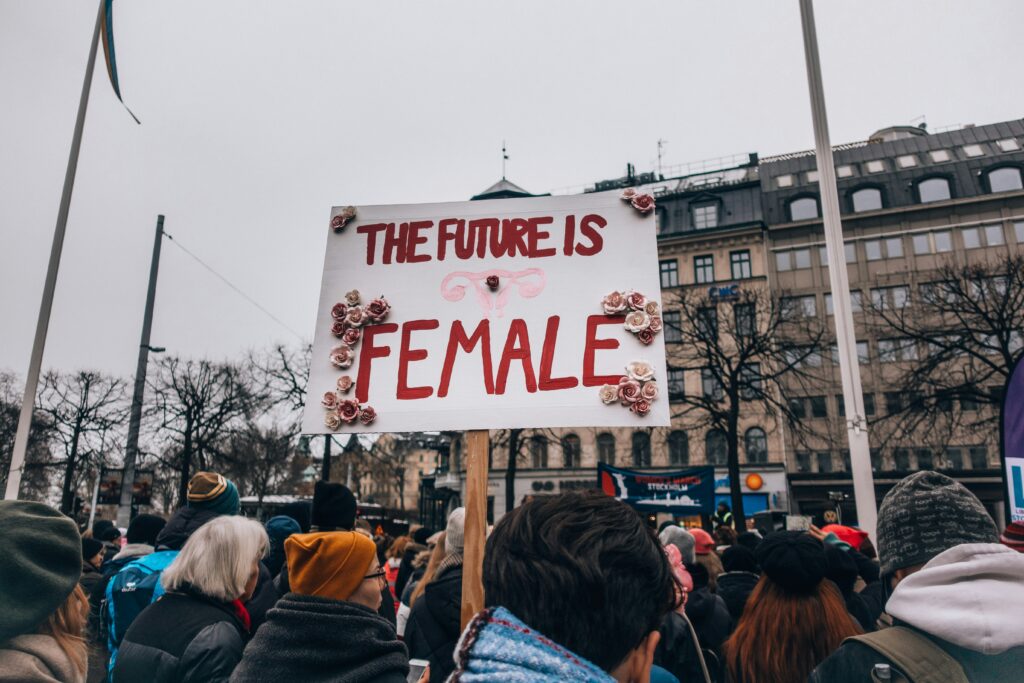
As crossroads for gender equality, feminism is a fundamental value of Amazone vzw. Our primary focus as an organization is the establishment of a society that is both feminist and egalitarian. But what is feminism? How did it come about and why is it important? The article below delves into the origins of feminism, its significance, and more.
A clear definition?
Defining feminism is not a straightforward task. The movement can be viewed as a type of patchwork, comprising a diverse range of perspectives, perceptions, and definitions. However, we can identify a common thread among all those who identify as feminists. Every feminist movement is rooted in the same fundamental principle: the pursuit of gender equality. While the understanding of what feminism entails may vary depending on the time period, location, or personal beliefs and experiences, combating discrimination based on gender remains the primary focus of all feminist movements.
Feminism in waves
When examining the history of feminism, historians frequently refer to ‘waves’ in an attempt to illustrate the progression of different feminist movements over time, including their emergence, peak, and eventual decline. The approach is frequently criticized, primarily because of an oversimplification of reality. However, the waves do provide a useful tool to describe the origins and evolution of the movement. In this summary, we utilize them to outline the general history and development of feminism, but we do follow up by a discussion of the criticisms and why it is important to take those into account.
Isolated water droplets – wave zero
Wave zero is not a commonly used term in the study of feminism, but we believe it is crucial to recognize that feminism has been present throughout history. The first ‘real’ feminist wave emerged in the 18th century, but feminist ideas existed way before then. Historically, women have often been treated lesser than their male peers, and resistance typically follows oppression. However, it is the establishing of a systematic feminist movement that proved to be challenging throughout time. Limited access to education and individual freedom hindered the development of a unified framework of thought until the 18th century.
Women as second-class citizens – The first feminist wave.
From the 18th century onwards, a very exclusive group of affluent white women gained access to education for the first time. Despite the Enlightenment’s emphasis on the equality of men during this period, women were still considered second-class citizens and not viewed as equals. The academic advancement of some women led to criticism of this notion. In the 19th century, this criticism evolved into the first organized feminist movement. The primary focus was on achieving formal equality for women and securing voting rights. It was also during this era that the first women’s associations began to emerge. The previously scattered protests were able to unify and professionalize, gaining leverage in the fight for equality. The utilisation of waves as a symbol for the feminist movement is also evident here. Despite the continuously ongoing quest for equality, there are fluctuations to be observed over time. For example, the two world wars facilitated a more balanced environment for women: as men were engaged in war, women had the opportunity to take charge of society. These historical periods are considered peaks in the wave, as women gained unprecedented rights. While the period between the wars is commonly viewed as a time of liberation, characterized by evolving fashion trends and extravagant Gatsby-esque parties, we witness women being constrained back into more conventional roles. Subsequently, the wave recedes temporarily. The world wars and the interwar period are undeniably crucial eras for the fight for gender equality. The essential role of women during these historical events guarantees a shift in the tide. After 1945, Western European countries slowly provided women with voting rights, signifying an important achievement for the women’s right movement.
The swinging sixties and the rise of secularization – the second wave of feminism
The post-World War II years are defined by the rebuilding and subsequent resurgence of the west. Emphasis is placed on personal freedom, with the 1960s and 1970s standing out as the period for music, the hippie movement, and the secularization of the church. Similarly, individual freedom became a central theme of the women’s movement. Feminism experiences a resurgence, with new themes emerging and medical and technological advancements fostering a new sense of liberation. Contraception empowers women to make their own decisions about having children, while innovations like washing machines greatly reduce the time spent on household chores. Key themes of this era include abortion, sexual freedom, and equal pay rights.
Black feminism and LGBTQIA+ – the third wave of feminism
Rapid technological advancements of the 20th century significantly influenced daily life. Globalization and modernization contributed to a more inclusive society. The same applied to feminism. The feminist movement that used to attract only white, Western European women saw a rise in alternative branches in the 1990s. The binary equation that earlier feminism depended on was now considered too simplistic for a world of increasing globalisation. Kimberlé Crenshaw, an Afro-American woman, coined the term intersectionality. This concept acknowledges that individuals belonging to multiple minority groups may face additional forms of discrimination. For example, someone who is both black and female encounters negative consequences stemming from both forms of oppression. This revelation initiated a new movement, first within academia and later extending to community and activist spheres. Black Feminism traces its roots back to this development. This movement advocates specifically for the inclusion of women of colour, a group that had previously been left out of the feminist narrative. LGBTQIA+ movements also joined the revitalized push for gender parity, with a focus on equality for all genders. Consequently, this feminist wave primarily centred around sexuality and identity issues.
#MeToo: A fourth wave of feminism?
Once more, technological advancements are bringing about transformations in society. Digitalization and globalization are reaching a (temporary) peak, leading to diversification and individualization within society. With numerous changes occurring, some specialists refer to this time period as a fourth feminist wave. The emergence of social media is transferring the battleground to the digital realm, enabling the feminist movement to reemerge. The #metoo movement, for instance, showcases the internet’s ability to spark global transformations. However, digitalization also presents its challenges. The online realm provides a platform for anti-feminist voices, exposing children to both dominant and less dominant ideas and perspectives from a young age. Feminism will need to rediscover its place in the evolving society. Only time will reveal if we can indeed refer to a fourth wave here.
Critiques on the waves
The feminist waves methodology offers a clear historical summary of feminism. Nevertheless, different voices raise their critique on the matter. Some argue that the depiction of feminist history in the form of waves is overly simplistic, leading to the neglect of non-dominant and smaller movements. The current definition of feminist waves offers a predominantly Eurocentric view, overlooking feminist initiatives in other regions of the world. Critics highlight the coexistence of various forms of feminism and stress that the fight for equality is continuously ongoing globally. Critics also highlight that the objectives of the second wave have not been fully met. Despite the ongoing endeavours of feminists around the world, a completely gender-equal society remains elusive today. This raises the question of whether a third or fourth wave should even exist. Therefore, while the feminist waves approach is commonly referenced, it is crucial to consider these criticisms in the examination and comprehension of feminism and its historical development.
To learn more about feminism, please visit our digital documentation centre or email us at docu@amazone.be.

Sara-Lynn Milis
Projects and resource centre


